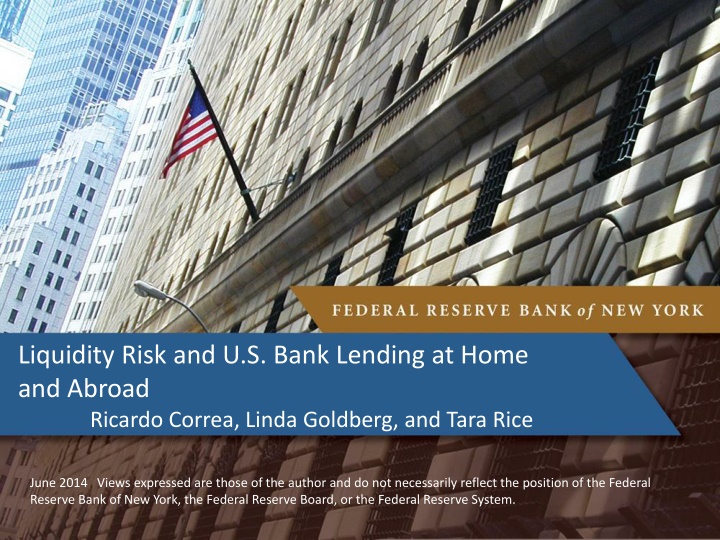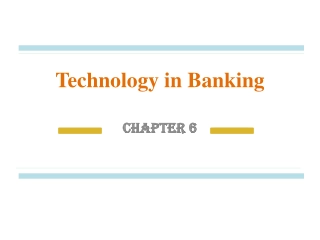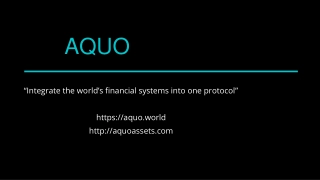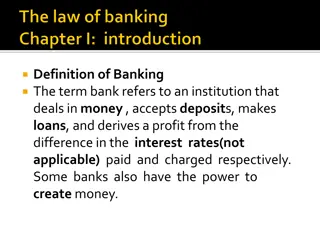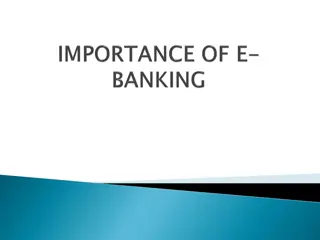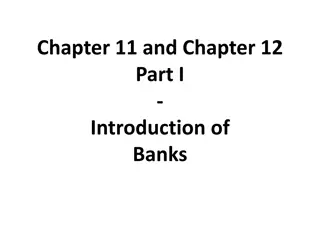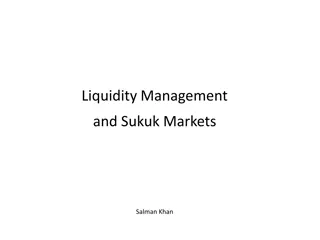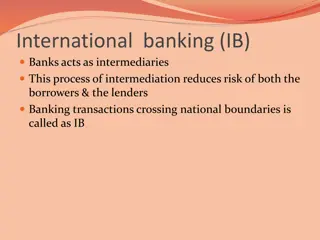Liquidity Risk in Global Banking
Global banking is interconnected, with implications for liquidity risk transmission in lending practices at home and abroad. Explore the research network's findings on bank balance sheet structures and vulnerabilities related to liquidity management.
Download Presentation

Please find below an Image/Link to download the presentation.
The content on the website is provided AS IS for your information and personal use only. It may not be sold, licensed, or shared on other websites without obtaining consent from the author.If you encounter any issues during the download, it is possible that the publisher has removed the file from their server.
You are allowed to download the files provided on this website for personal or commercial use, subject to the condition that they are used lawfully. All files are the property of their respective owners.
The content on the website is provided AS IS for your information and personal use only. It may not be sold, licensed, or shared on other websites without obtaining consent from the author.
E N D
Presentation Transcript
Liquidity Risk and U.S. Bank Lending at Home and Abroad Ricardo Correa, Linda Goldberg, and Tara Rice June 2014 Views expressed are those of the author and do not necessarily reflect the position of the Federal Reserve Bank of New York, the Federal Reserve Board, or the Federal Reserve System.
Motivation Banking is increasingly globalized, with direct linkages internationally through cross-border transactions, and branches and subsidiaries established abroad. Global banks were central to the recent financial crises, and some flows through these banks were volatile. Little is known about reasons for the volatility and the consequences of various forms of official sector liquidity. Micro-banking data is key. Provides an ability to see the (broad contours of the) balance sheets of banks, with domestic, internal, and international lending. Challenges: Getting data; appropriately designing analytical experiments; providing insights beyond country or episodic case studies. 2
One approach: the International Banking Research Network IBRN Established in 2012, first project 2013. Transmission of liquidity risk into lending by banks Conceptual: extends Khwaja and Mian AER 2008 Empirical: extends Cornett, McNutt, Strahan and Tehranian JFI 2011 International: continues development of insights on transmission through global banks, including on roles of internal capital markets, complex organizations, core and periphery locations for parents Main issues addressed How does the structure of bank balance sheets influence the transmission of liquidity risk into their lending at home and abroad? Are there vulnerabilities to address? How do banks use their affiliates for liquidity? What is prioritized? What happens when official sector liquidity is provided? 3
Conceptual underpinnings for internal use only
Baseline Scenario From Khwaja and Mian (AER 2008) ??. In period t, a representative bank i and firm j negotiate a loan ?? Bank i funding: Deposits ?? until a certain scale of activity is reached. Additional external financing ??? available to bank i with the marginal cost of funds given by ????? with ??> 0. ??, which are costless (or priced at a low fixed rate) , Firm j credit demand: Marginal returns on loans are decreasing in loan size with every counterparty ?? ? ???? ??. 5
Baseline Scenario At the end of period t, two types of shocks hit the economy. Aggregate credit supply shock ?? Bank-specific or idiosyncratic shock ?? ?. Also, credit demand shocks work through the marginal returns on loans, increasing with aggregate and idiosyncratic productivity shocks ?? and ?? ?. Jointly solving the first order conditions for loan supply and demand in each period, KM 2008 derive (1), here amended with time subscripts: )( L B + + 1 1 + ) = + + + ij t i j + L B (1) ( ( ) ( ) + + + + 1, 1 1 1 1 t B t t t t L B L B 6
Baseline Scenario ? ??? ??? and re-write (1) Buch and Goldberg (2014) substitute ?? Result: time-series panel specification where ex-ante balance sheet composition influences the adjustment of lending to the market price of liquidity risk ??? : + 1 + 1 + )( ) = + + + ij t i t c j + L r B (2) ( ( ) ( ) + + + 1, 1 1 1 t B t t t t L B L B L B The interactions between ??? ??? show which balance sheet characteristics of banks drive responses of lending to liquidity risk, similar to Cornett, McNutt, Strahan and Tehranian JFI 2011. Buch and Goldberg (2014) also derive a role for official liquidity provision in relation to firm characteristics, instead of splitting the sample period as CMST 2011 or just adding crisis dummy variables. 7
Baseline Scenario ???? External Finance Cost ?0 ? = ? ? = 1 ? = 2 Bank Characteristic ?? 8
Baseline Scenario ???? External Finance Cost ?1 ?0 ? = ? ? = 1 ? = 2 Bank Characteristic ?? 9
Baseline Scenario ???? External Finance Cost ?2 ?1 ?0 ? = ? ? = 1 ? = 2 Bank Characteristic ?? 10
Baseline Scenario ???? ?,???? ?2 External Finance Cost ?,???? ?1 ?,???? ?0 ?2 ?1 ?0 ? = ? ? = 1 ? = 2 Bank Characteristic ?? 11
Baseline Scenario: effective price of liquidity varies over time and with bank characteristics i. ???? ? = 1 External Finance Cost ? = 2 ? = ? ?0 ?1 ?2 12
With Public Liquidity Provision: if high cost, no effect. ???? ?,??? ?0 ?,???? ?2 External Finance Cost ?,???? ?1 ?2 ?1 ?0 ? = ? ? = 1 ? = 2 Bank Characteristic ?? 13
With Public Liquidity Provision: if cost declines, impact is on liquidity schedule for weaker banks. ???? ?,??? ?0 ?,???? ?2 External Finance Cost ?,???? ?1 ?,??? ?1 ?2 ?1 ?0 ? = ? ? = 1 ? = 2 Bank Characteristic ?? 14
The lower the cost of emergency lending, the broader the group getting non-market funds. ???? ?,??? ?0 ?,???? ?2 External Finance Cost ?,???? ?1 ?,??? ?1 ?,??? ?1 ?2 ?1 ?0 ? = ? ? = 1 ? = 2 Bank Characteristic ?? 15
With Public Liquidity Provision ???? ?,??? ?0 ? = 1 External Finance Cost ? = 2 ? = ? ?0 ?1 ?2 16
With Public Liquidity Provision: a kink introduced for some weaker borrowers in time-series. ???? ?,??? ?0 ? = 1 External Finance Cost ? = 2 ?,??? ?1 ? = ? ?0 ?1 ?2 17
With Emergency Lending, even stronger users will pay at official price, instead of market price. ???? ?,??? ?0 ? = 1 External Finance Cost ?,??? ?1 ? = 2 ? = ? ?,??? ?1 ?0 ?1 ?2 18
Application to US micro-banking data for internal use only
Regression Specification applied to US data on large banks ( ( LIB OIS X + + ) ) = + + + 0 1 _ Y LIB OIS X , 1 it i t t i t + 0 1 _ F , 1 t i t it it ??? : loans to domestic counterparties, loans to foreign counterparties, total credit extension, and net due to balances. ??,? 1is a vector that captures the degree to which a bank is exposed to liquidity risk through ex ante balance sheet composition and market access, as in CMST2011. LIBOR over OIS spread as a measure of liquidity risk. Indicator variable ??? (Facility), 1 if a bank i accessed the discount window or the TAF in quarter t. Bank (??) and time (??) fixed effects included ?1 reflect cross-sectional differences in balance sheet compositions on the liquidity risk effects, or with facility use + 1 1 20
The regression sample: Large U.S. Bank-holding Companies With Foreign Affiliates Without Foreign Affiliates (n=73) Median (n=23) Variable Balance sheet data (for each bank i and quarter t): 2006Q1 to 2012Q4 Dependent Variables Credit/(Assets + Commitments) (%) Domestic C&I Loans/Assets (%) Foreign C&I Loans/Assets (%) Cross-Border Claims/Assets (%) Foreign-Office Claims/Assets (%) Net Due To (Head Office)/Assets (%) Median SD SD 0.18 0.09 0.00 0.01 0.01 0.00 2.73 0.74 0.17 1.19 0.90 1.54 0.55 0.11 0.00 2.48 0.74 0.06 Independent Variables Illiquid Assets/Assets (%) Commitments Ratio (%) Log Real Assets Core Deposits/Liabilities (%) Tier1 Capital/RWA (%) Net Due To(Head Office)/Liabilities(%) Facility Use 75.32 27.48 18.89 51.47 10.90 3.56 0.00 18.28 10.90 1.60 21.46 2.90 8.62 0.39 78.75 19.02 16.72 67.85 11.05 14.60 11.32 1.01 16.70 10.90 0.00 0.37 21
The regression sample: Large U.S. Bank-holding Companies With Foreign Affiliates Without Foreign Affiliates (n=73) Median (n=23) Variable Balance sheet data (for each bank i and quarter t): 2006Q1 to 2012Q4 Dependent Variables Credit/(Assets + Commitments) (%) Domestic C&I Loans/Assets (%) Foreign C&I Loans/Assets (%) Cross-Border Claims/Assets (%) Foreign-Office Claims/Assets (%) Net Due To (Head Office)/Assets (%) Median SD SD 0.18 0.09 0.00 0.01 0.01 0.00 2.73 0.74 0.17 1.19 0.90 1.54 0.55 0.11 0.00 2.48 0.74 0.06 Independent Variables Illiquid Assets/Assets (%) Commitments Ratio (%) Log Real Assets Core Deposits/Liabilities (%) Tier1 Capital/RWA (%) Net Due To(Head Office)/Liabilities(%) Facility Use 75.32 27.48 18.89 51.47 10.90 3.56 0.00 18.28 10.90 1.60 21.46 2.90 8.62 0.39 78.75 19.02 16.72 67.85 11.05 14.60 11.32 1.01 16.70 10.90 0.00 0.37 22
US Domestic, Foreign, and Internal Lending, aggregates US Domestic, Foreign, and Internal Lending 250 200 150 100 Index 50 0 -50 -100 2006 2007 2008 2009 2010 2011 2012 Foreign Lending Domestic Lending Net Due 23
LIBOR OIS Spread LIBOR - OIS Spread (US Dollar) 3 2.5 Interest rate spread (%) 2 1.5 1 0.5 0 2006 2007 2008 2009 2010 2011 2012 2013 24
Drivers of Cross-Sectional Differences in Credit and Lending Growth through Liquidity Risk (select coefficients shown) : 1 Panel A: Banks without Foreign Affiliates Domestic C&I Loans/Assets 0.000 -0.004 0.010 -0.007 0.007** 0.000 0.003 -0.004 Credit/ (Assets + Commitments) 0.020 -0.018 0.012 -0.014 0.007 0.051** 0.016 0.011 Foreign C&I Loans/Assets 0.000 0.000 0.001 0.000 -0.001*** 0.000 -0.001 0.000 Variables interacted with Libor_OIS Illiquid Assets Illiquid Assets* Facility Commitment Ratio Commitment Ratio*Facility Core Deposits Core Deposits*Facility Tier 1/RWA Tier 1/RWA*Facility Observations Number of banks Adjusted R-squared 1,415 73 0.15 1,415 73 0.02 1,415 73 0.18 25
Drivers of Cross-Sectional Differences in Credit and Lending Growth through Liquidity Risk (select coefficients shown) : 2 Panel A: Banks without Foreign Affiliates Foreign C&I Loans/Assets Credit/ (Assets + Commitments) Domestic C&I Loans/Assets During periods of Central Bank Facility Use Illiquid Assets Commitment Ratio Core Deposits Tier 1/RWA -0.005 0.003 0.006 -0.001 -0.001 0.000 -0.001*** -0.001 0.002 -0.002 0.058** 0.027 26
Drivers of Cross-Sectional Differences in Credit and Lending Growth through Liquidity Risk (select coefficients shown) : 3 Panel B: Banks with Foreign Affiliates Credit/ (Assets + Commitments) 0.102* -0.034 -0.087 0.052 -0.001 -0.001 0.250 0.135 0.166*** -0.130** Domestic C&I Loans/Assets 0.013 -0.020 -0.004 0.005 0.007 0.009 -0.002 0.104* 0.045*** -0.035** Foreign C&I Loans/Assets 0.007 -0.007* 0.002 -0.005 -0.001 0.004 -0.018 0.022 0.010*** -0.008* Variables interacted with Libor_OIS Illiquid Assets Illiquid Assets*Facility Commitment Ratio Commitment Ratio*Facility Core Deposits Core Deposits*Facility Tier 1/RWA Tier 1/RWA*Facility Net Due To (Head Office) Net Due To (Head Office)*Facility Observations Number of banks Adjusted R-squared 505 27 0.40 505 27 0.07 505 27 0.38 27
Drivers of Cross-Sectional Differences in Credit and Lending Growth through Liquidity Risk (select coefficients shown) : 4 Panel B: Banks with Foreign Affiliates Domestic C&I Loans/Assets Foreign C&I Loans/Assets Credit/ (Assets + Commitments) During Periods of Central Bank Facility Use Illiquid Assets Commitment Ratio Core Deposits Tier 1/RWA Net Due To (Head Office) -0.007 0.000 0.016 0.102*** 0.010 0.000 -0.003 0.003 0.003 0.002 0.068** -0.034 -0.003 0.385* 0.036 28
Drivers of Cross-Sectional Differences in Credit and Lending Growth through Liquidity Risk (select coefficients shown) : 5 Panel B: Banks with Foreign Affiliates Net Due To (Head Office)/ Assets -0.026 -0.087* 0.066* -0.034 0.006 0.091** -0.248 -0.270*** 0.034 -0.082 Cross-border Claims/Assets 0.045** -0.040* 0.040** -0.014 -0.019 0.029 -0.148 0.031 0.059*** 0.014 Foreign-office Claims/Assets 0.035 -0.039 0.005 -0.020** -0.004 0.027 -0.110 0.064 0.005 0.007 Variables interacted with LIBOR_OIS Illiquid Assets Illiquid Assets*Facility Commitment Ratio Commitment Ratio*Facility Core Deposits Core Deposits*Facility Tier 1/RWA Tier 1/RWA*Facility Net Due To (Head Office) Net Due To (Head Office)*Facility Observations Number of banks Adjusted R-squared 502 27 0.08 483 27 0.12 505 27 0.23 29
Drivers of Cross-Sectional Differences in Credit and Lending Growth through Liquidity Risk (select coefficients shown) : 6 Panel B: Banks with Foreign Affiliates Net Due To (Head Office)/ Assets Cross-border Claims/Assets Foreign-office Claims/Assets During Periods of Central Bank Facility Use Illiquid Assets Commitment Ratio Core Deposits Tier 1/RWA Net Due To (Head Office) 0.005 0.026** 0.010 -0.118 0.073*** -0.005 -0.015 0.023 -0.046 0.012 -0.112*** 0.032 0.097*** -0.518*** -0.048 30
Conclusions on responses to liquidity risks (1) Cross-border lending is more volatile and more prone to constraints on banks through their balance sheets. Local claims by affiliates less well explained by parent balance sheets. Large US global banks differ from large domestic banks Banks without foreign affiliates: loan growth differs cross- sectionally with reliance on core deposits. Global banks: loan growth differs with liquidity management within the broader organization. more borrowing from affiliates associated with more stable domestic lending and credit growth as liquidity risk worsens. borrowing and lending vis- -vis affiliates adjusts in line with their balance sheet composition. 31
Conclusions on responses to liquidity risks (2) When banks access official liquidity facilities, Different balance sheet characteristics matter for cross-sectional lending variation. Growth in net borrowing from affiliates falls more for banks with more illiquid assets and fewer core deposits. Internal net borrowing appears less important in differences in lending to domestic and foreign customers. The results provided are economically significant. Understanding these responses are important for understanding the large cycles in capital flows through banks as liquidity conditions change in normal times and crisis periods. 32
Thank you. for internal use only
Second Methodology ( ) = + + + + + 0 1 2 3 c i r t c c _ _ Y LIB OIS X LIB OIS X X , 1 i t , 1 i t , 1 i t it t t ( ) + + + 1 3 c _ _ LIB OIS LIB OIS X X F , 1 i t , 1 i t t t it it ??? is a claim of bank i on a resident of country c at time t, which can take the form of cross-border lending (claims) or local claims extended through overseas branches or subsidiaries. Strategic importance variables are measures of whether countries are core investment or funding location for each parent bank I within location c ?? ?,? 1). Core funding location for bank i : the local foreign offices fund their operations largely through local borrowing, Core investment location for bank i represents a large share of overall foreign investments (claims) of bank i. The estimating equation includes region-time fixed effects to absorb changes in demand conditions in each region (?? ?). 34
